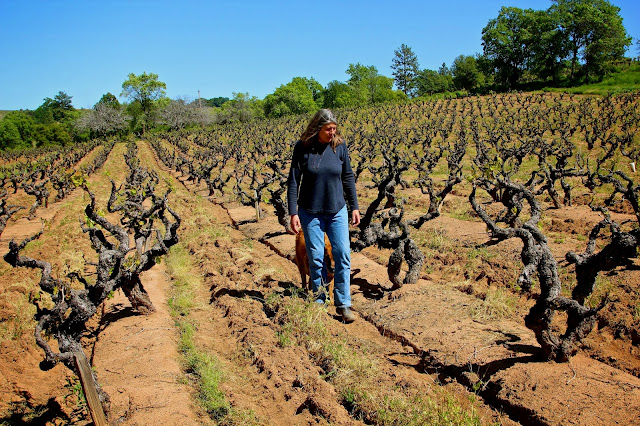Organic wine & food matching:: Robert Sinskey Marcien & Maria Helm's braised veal shanks
 When Biodynamic® guru Alan York began consulting with winegrower/proprietor Rob Sinskey of Robert Sinskey Vineyards (a.k.a. RSV), the first thing he advised was to “get over the voodoo doo-doo” and find the “practical ways to get it done.” “I was never that heavy into Rudolf Steiner’s spiritual philosophy anyway,” confesses Sinskey, “but what makes sense are the steps that give your vineyard a distinctive personality… if it means planting according to the rhythms of the earth and employing sheep herders to mow the grass, so be it.”
When Biodynamic® guru Alan York began consulting with winegrower/proprietor Rob Sinskey of Robert Sinskey Vineyards (a.k.a. RSV), the first thing he advised was to “get over the voodoo doo-doo” and find the “practical ways to get it done.” “I was never that heavy into Rudolf Steiner’s spiritual philosophy anyway,” confesses Sinskey, “but what makes sense are the steps that give your vineyard a distinctive personality… if it means planting according to the rhythms of the earth and employing sheep herders to mow the grass, so be it.”Although Biodynamic® certification didn’t come to RSV until 2007, the original “tipping point” for Sinskey goes back to1990; when he observed one of his Chardonnay blocks in Carneros shutting down and phylloxera strangling the vines. “At that time we were spraying and constantly sterilizing the soil to the point which it had basically become a ‘dead zone,’ showing little sign of life, almost no birds or earthworms to be found. It was our winemaker, Jeff Virnig, who originally brought up the subject one day by asking, ‘wouldn’t it be cool if we were organic?’”
So throughout the ‘90s Sinskey’s goal was to jump-start microbial activity in the soils of his property – 5 acres around the RSV winery in Napa Valley’s Stag’s Leap District, and another 200 or so in the Los Carneros AVA – by ceasing the use of chemical fertilizers, pesticides and the like; and by 2001, when RSV received its CCOF certification, the earthworms and birds were back in multitudes.
 Sinskey’s vineyard manager, Debby Zygielbaum, is both meticulous and obsessive in her aversion to, in her words, “better living through chemicals.” “It’s not like we have it easy,” she tells us, while driving us through her “shaggy” vineyards – bespoke with varieties of grass, poppies, ponds, fruit and olive trees, and even a pristine pasture for a bourgeoning flock of sheep – up and down the Carneros hillsides.
Sinskey’s vineyard manager, Debby Zygielbaum, is both meticulous and obsessive in her aversion to, in her words, “better living through chemicals.” “It’s not like we have it easy,” she tells us, while driving us through her “shaggy” vineyards – bespoke with varieties of grass, poppies, ponds, fruit and olive trees, and even a pristine pasture for a bourgeoning flock of sheep – up and down the Carneros hillsides.“One of our biggest barriers,” according to Zygielbaum, “is powdery mildew, for which 508 (the anti-fungal Biodynamic® tea spray prepared from horsetail) is not enough” – and so she finds it necessary to supplement with some sulphur. “Gophers, mealy bugs, nematodes, you name it, we got it, and we take organic measures to keep things in balance. But at the end of the day, the pay-off for what we do in the vineyard is in the wine: in this day and age of Robert Parker and wines that taste all the same, there’s something beautiful about something that tastes of a place, and I think we’ve got that.”
Which brings us to RSV’s top-of-the-line blend of Merlot, Cabernet Sauvignon and Cabernet Franc, which Sinskey affectionately calls Marcien – French for “from Mars” (or, “you must be crazy”). Says Sinskey, “we call it Marcien because when we first started planting Bordeaux grapes in Carneros (a cold region with shallow clay soils rather than the deep gravel and moderate climate associated with Bordeaux), some people thought we were nuts. But you taste the wine and tell us what you think.”
What do I think? If you’re a wine lover who prizes the elegance and deep, compact intensity of red Bordeaux, the 2005 Robert Sinskey Vineyards Los Carneros Marcien (about $50) will blow you away! No, it’s not “Bordeaux,” it’s Carneros grown Merlot – luscious, velvety, seamlessly textured – knit to the black, wild, plummy, licorice, gnarly tobacco, and smoky room qualities associated with the Cabernet grapes. Since Sinskey also happens to be married to Maria Helm – a great chef, formerly of the San Francisco’s recently shuttered Plumpjack Café –the Marcien’s ideal food context is also key to maximum consumption. The Sinskeys recommend this recipe for braised veal shanks with olives and bay leaves… double-wow!






Comments